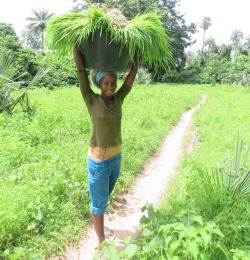African rice farmers suffer hunger because of Dutch dairy industry

Black-tailed godwits migrating from the Netherlands back to Africa after the breeding season are arriving there increasingly early. This causes huge problems for African rice farmers. Black-tailed godwits used to return in August, but as a result of changes in how Dutch dairy farms operate, they now often come back as early as July. At this time of the year African farmers have only just sown their rice, which increasingly often ends up in godwit stomachs. This was the discovery made last month by University of Groningen researchers Jos Hooijmeijer and Haije Valkema during an expedition to the Casamance, an area in southern Senegal where a lot of rice is grown.
For the last twelve years, the team of the University of Groningen Conservation Ecology group has been studying black-tailed godwits in southwest Friesland, for instance by equipping the birds with satellite transmitters (http://volg.keningfanegreide.nl/). The research shows that the Casamance in Senegal is an important area for our godwits. The Groningen researchers indeed discovered thousands of birds in this area by mid-August. They were primarily to be found in the rice fields, feasting on the recently sown rice.
Desperate rice farmers
‘In our work we were accosted literally every day by desperate rice farmers who are watching their rice disappear into the stomachs of hungry godwits,’ says Jos Hooijmeijer. ‘They have noticed that over the last twenty years, the birds have been returning from the Netherlands increasingly early. In response, many farmers have abandoned their former habit of sowing directly in the rice fields. They now prefer to pre-sow the rice on seedbeds placed between houses before collecting the seedlings and taking them to the rice fields to be planted by hand: an incredible amount of additional work! Furthermore, space limitations sometimes force farmers to create seedbeds in more open spaces, where the godwits are quick to find them.’

Dutch grassland management
The reason for the godwits’ accelerated return lies in changes in how Dutch dairy farms operate. In order to increase production, grasslands are severely drained, heavily fertilized, levelled and sown using grasses with increasingly high yields that can be planted early in the year. It is by now generally accepted that this is the driving factor behind the large-scale disappearance of farmland birds including the black-tailed godwit. Under these conditions the birds are simply unable to raise enough chicks. At present more than 80% of the godwits fail in their breeding attempts and leave the Netherlands prematurely.
Impenetrable
This is not only a problem with birds that lose their brood – successful birds sometimes leave as early as late June too. This is because heavily drained farmlands have nothing to offer the birds after the breeding season; the soil becomes impenetrable for godwit beaks in search of worms. Senegalese rice farmers therefore have to accommodate an ever greater portion of the Dutch godwit population at a very inconvenient time. Hooijmeijer: ‘In this way our agro-industry not only threatens the black-tailed godwit, but also African rice farmers 5,000 kilometres away.’
More information
- Contact: Drs. Jos Hooijmeijer, Groningen Institute for Evolutionary Life Sciences (GELIFES), University of Groningen
More news
-
02 December 2025
Student Menna Zahran wins Unilever Research Prize
-
27 November 2025
Aeroplane spotting using a radio telescope
-
26 November 2025
Why are shiny colours rare yet widespread in nature?
